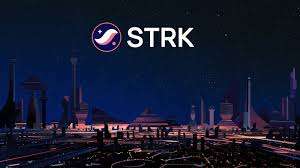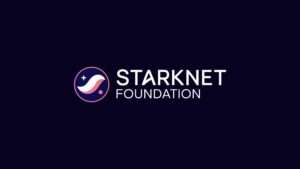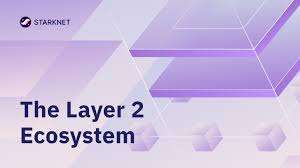Latest News
- Starknet (STRK) Eyes Recovery With Improving Indicators
- 3 Token Unlocks for the Third Week of April 2025
- New StarkWare Research Proposes Capital-Efficient Bitcoin Smart Contracts
- Strategy’s Bitcoin Holdings Keep Growing—Another $1.92B Invested
Current Price
The current price of STRK is $0.13018
Introduction
Starknet (STRK) has emerged as a significant Layer 2 solution on the Ethereum blockchain, harnessing the power of zero-knowledge rollups to effectively address scalability and efficiency concerns.
With its emphasis on robust security and a supportive environment for developers, Starknet facilitates the development of sophisticated decentralized applications across various sectors such as DeFi and gaming.
As the platform continues to evolve, understanding its intricate features and potential implications for stakeholders becomes essential.
What remains to be seen is how Starknet will navigate the competitive landscape and what future developments may lie ahead.
Let’s dive in!
Quick Overview
- Starknet is a Layer 2 solution on Ethereum, enhancing scalability and efficiency through zero-knowledge rollups (ZK-rollups) for faster transactions and lower fees.
- The STRK token facilitates governance, incentivizes validators, and is necessary for transaction fees, aligning user interests with network performance.
- Starknet supports a developer-friendly environment with tools like StarkNet.js and Cairo, promoting innovative dApps and smart contract development.
- The platform addresses high transaction volumes in decentralized finance (DeFi) and NFTs, making it suitable for various applications in the blockchain space.
- Future developments aim to increase transaction throughput and implement cross-chain interoperability, positioning Starknet as a leader in decentralized solutions.

Overview of Starknet
Starknet represents a significant advancement in the landscape of blockchain scalability and efficiency. It operates as a Layer 2 solution built on Ethereum, utilizing zero-knowledge rollups (ZK-rollups) to enhance transaction throughput while maintaining the security and decentralization inherent to the Ethereum network. By aggregating multiple transactions into a single proof, Starknet minimizes the data that needs to be processed on-chain, thereby alleviating congestion and reducing gas fees.
The architecture of Starknet is designed to facilitate complex smart contracts and decentralized applications (dApps) without compromising performance. Its unique approach allows for the execution of more sophisticated computations off-chain, with the results verified on-chain, ensuring both security and scalability. This is particularly essential as the demand for blockchain solutions continues to grow, placing increasing pressure on existing networks.
Furthermore, Starknet employs a modular design, which provides flexibility in adapting to various use cases and integrations. As the blockchain ecosystem evolves, Starknet’s structure positions it to effectively respond to emerging challenges while supporting a diverse range of applications.
This combination of technological innovation and strategic design underscores Starknet’s potential as a transformative force within the blockchain landscape.
Key Features of Starknet
Starknet offers a range of key features that address critical aspects of blockchain technology, specifically focusing on scalability, security, and developer engagement.
The platform employs innovative scalability solutions to enhance transaction throughput while maintaining robust security mechanisms to protect against potential vulnerabilities.
Additionally, its developer-friendly environment facilitates easier access and integration for building decentralized applications, thereby fostering innovation within the ecosystem.
Scalability Solutions Offered
A thorough analysis of the scalability solutions offered by Starknet reveals a robust framework designed to enhance transaction throughput and reduce costs on the Ethereum network. Central to Starknet’s approach is its implementation of zero-knowledge rollups (zk-rollups), which allow for the aggregation of multiple transactions into a single proof. This considerably reduces the data burden on the Ethereum main chain, thereby enabling higher transaction volumes without compromising security.
Starknet employs a unique architecture that separates the execution of transactions from their settlement on the Ethereum blockchain, effectively offloading computational work while ensuring that data availability remains intact. As a result, users experience faster transaction confirmations and lower fees, making the platform more accessible for various decentralized applications (dApps) and services.
Additionally, Starknet’s scalability solutions include a layered system that facilitates seamless interactions among multiple smart contracts and dApps, promoting interoperability and enhancing the overall user experience.
Security Mechanisms Explained
The security mechanisms integrated within the Starknet framework are essential for maintaining the integrity and reliability of its scalability solutions. As blockchain technology continues to evolve, the need for robust security measures becomes ever more vital.
Starknet employs several key features designed to safeguard its ecosystem:
- Zero-Knowledge Proofs (ZKPs): Starknet utilizes ZKPs to guarantee that transactions are validated without revealing any sensitive information. This cryptographic technique enhances privacy while maintaining transparency.
- Decentralized Consensus: By leveraging a decentralized consensus mechanism, Starknet mitigates the risks associated with single points of failure. This structure not only enhances security but also guarantees that the network remains resilient against attacks.
- Smart Contract Audits: Regular audits of smart contracts are conducted to identify vulnerabilities and guarantee compliance with best practices. This proactive approach is essential for maintaining the trust of users and stakeholders within the network.
These mechanisms collectively contribute to a fortified security posture, allowing Starknet to scale effectively while minimizing exposure to potential threats.
Understanding these features is vital for stakeholders aiming to engage with the Starknet ecosystem responsibly.

Developer-Friendly Environment
How can blockchain platforms effectively empower developers to create innovative applications? Starknet stands out through its commitment to a developer-friendly environment characterized by several key features.
It leverages zk-rollups, which enhance scalability and efficiency by enabling off-chain computation while maintaining on-chain security. This architecture not only reduces transaction costs but also facilitates high throughput, allowing developers to focus on building complex applications without the hindrance of network congestion.
Moreover, Starknet employs a Layer 2 solution that supports Ethereum’s smart contracts, enabling developers familiar with Ethereum’s ecosystem to shift seamlessly. The platform’s compatibility with popular programming languages, such as Cairo, further streamlines the development process, as it encourages a wider range of programming expertise.
Additionally, Starknet’s robust documentation and active community support provide essential resources for developers, fostering collaboration and innovation. The incorporation of modular components allows for customizable solutions, catering to diverse project requirements.
Collectively, these elements create a conducive environment for developers, promoting the creation of scalable, efficient, and innovative applications within the Starknet ecosystem.
How Zero-Knowledge Rollups Work
Zero-Knowledge Rollups (ZK-Rollups) enhance blockchain scalability by processing transactions off-chain while maintaining the security of the main chain.
This technology leverages cryptographic proofs to guarantee that only valid transactions are recorded, thereby improving performance without compromising data privacy.
The benefits of ZK-Rollups are particularly significant in high-demand environments, where efficient transaction processing can alleviate network congestion and lower costs.

Benefits of Zero-Knowledge
An increasing number of blockchain solutions are leveraging Zero-Knowledge Rollups (zk-rollups) to enhance scalability and privacy. By allowing transactions to be processed off-chain while retaining the security of the main blockchain, zk-rollups offer several compelling benefits, making them an attractive option for developers and users alike.
- Enhanced Privacy: zk-rollups utilize cryptographic proofs to validate transactions without revealing specific transaction details. This guarantees user confidentiality while maintaining the integrity of the network.
- Reduced Costs: By aggregating multiple transactions into a single proof, zk-rollups markedly decrease the amount of on-chain data required. This leads to lower transaction fees, making blockchain interactions more economically feasible.
- Increased Throughput: As zk-rollups bundle transactions, they alleviate congestion on the main chain, enabling a higher volume of transactions to be processed simultaneously. This capability is essential for applications that demand high performance and responsiveness.
Scalability and Performance
Leveraging cryptographic techniques, zk-rollups greatly enhance the scalability and performance of blockchain networks. They achieve this by bundling multiple transactions into a single proof, which is then submitted on-chain, considerably reducing the amount of data that needs to be processed by the main blockchain. This mechanism alleviates congestion on the base layer, allowing for a higher throughput of transactions without compromising security.
The core of zk-rollups lies in zero-knowledge proofs, which allow one party to prove to another that a statement is true without revealing any specific information about the statement itself. In the context of blockchain, this means that transaction validity can be confirmed without needing to disclose all underlying data. As a result, zk-rollups maintain robust privacy while ensuring that the network can accommodate an increased number of transactions.
Moreover, zk-rollups can enhance user experience by lowering transaction fees, as the cost is distributed across multiple transactions within a batch. This combination of efficiency, cost-effectiveness, and security positions zk-rollups as a powerful solution for addressing the scalability challenges that have historically hindered blockchain adoption.
Therefore, they represent a considerable advancement in optimizing blockchain performance.
Starknet’s Ecosystem and Partnerships
Starknet’s ecosystem is characterized by a robust infrastructure that facilitates scalable decentralized applications (dApps) through its unique Layer 2 solution. This architecture leverages zk-rollups, allowing for high throughput while maintaining security and reducing costs.
As Starknet continues to grow, it has established various partnerships that enhance its capabilities and broaden its application base.
Key elements of Starknet’s ecosystem include:
- Developer Tools: Starknet offers a suite of developer tools, including StarkNet.js and Cairo programming language, which simplify the process of building dApps and integrating with the network.
- Existing Partnerships: Collaborations with established blockchain projects, such as Immutable and dYdX, facilitate the integration of Starknet’s technology into widely-used platforms, enhancing user experience and expanding its reach.
- Community Engagement: A vibrant community of developers and users fosters innovation and feedback, ensuring that the ecosystem evolves in line with user needs and technological advancements.
These components collectively position Starknet as a formidable player in the blockchain landscape, aimed at driving the adoption of scalable solutions and enabling a diverse range of decentralized applications.
Use Cases for Starknet
Starknet presents a range of use cases that capitalize on its unique architecture, particularly in decentralized finance applications, gaming, and non-fungible tokens (NFTs).
Its capacity to enhance scalability for Ethereum further positions Starknet as a pivotal player in addressing the limitations of current blockchain networks.
This multifaceted utility not only fosters innovation but also expands the potential for widespread adoption within various sectors.
Decentralized Finance Applications
In the rapidly evolving landscape of decentralized finance (DeFi), Starknet emerges as a promising layer-2 solution designed to enhance scalability and efficiency for Ethereum-based applications.
By leveraging zk-rollup technology, Starknet facilitates faster transaction processing and reduced gas fees, making it an attractive option for DeFi developers and users.
The potential use cases for Starknet within the DeFi sector include:
- Decentralized Exchanges (DEXs): Starknet can support high-throughput DEXs that provide seamless trading experiences while minimizing latency and transaction costs, thereby attracting more users and liquidity.
- Lending and Borrowing Platforms: With Starknet’s scalability, lending protocols can offer competitive interest rates and efficient collateral management, enabling users to engage with financial services without the prohibitive costs typically associated with Ethereum transactions.
- Yield Farming and Staking: Starknet allows for the creation of complex yield farming strategies that can optimize returns for users, all while ensuring that smart contracts execute quickly and reliably.
Gaming and NFTs
A considerable opportunity lies in the integration of Starknet within the gaming and non-fungible token (NFT) sectors, where the need for enhanced scalability and lower transaction costs is paramount.
The gaming industry is experiencing an exponential rise in user engagement and asset creation, necessitating a blockchain infrastructure capable of supporting high transaction volumes without compromising speed or cost-efficiency. Starknet’s ZK-rollup technology provides a robust solution, allowing for numerous transactions to be bundled and processed off-chain, thereby reducing the on-chain load.
In the context of NFTs, Starknet enables creators and developers to mint, trade, and manage digital assets with considerably lower gas fees compared to traditional Ethereum transactions.
This fosters a more accessible environment for both creators and collectors, promoting greater participation in the NFT marketplace. Additionally, the programmability of Starknet allows for innovative gaming mechanics, such as play-to-earn models and in-game asset ownership, enhancing player engagement and retention.
Scalability Solutions for Ethereum
The scalability challenges faced by Ethereum have prompted the exploration of advanced solutions, with Starknet emerging as a prominent contender.
Leveraging zk-rollups, Starknet enables significant improvements in transaction throughput while maintaining Ethereum’s security and decentralization. This Layer 2 solution provides a framework that can accommodate a variety of use cases, ultimately enhancing Ethereum’s usability.
Starknet’s scalability solutions can be categorized into three primary use cases:
- Decentralized Finance (DeFi): Starknet facilitates faster and cheaper transactions, allowing DeFi protocols to scale effectively, reducing congestion and improving user experience.
- Gaming: By handling high volumes of microtransactions efficiently, Starknet supports gaming ecosystems that require rapid interactions without compromising on security.
- Non-Fungible Tokens (NFTs): Starknet’s architecture enables the minting and trading of NFTs at scale, addressing the issues of high gas fees and slow transaction times that have plagued the Ethereum network.
Comparison With Other Layer-2 Solutions
Numerous Layer-2 solutions have emerged to address scalability and transaction efficiency in blockchain networks, each offering unique features and trade-offs.
Starknet, built on zero-knowledge rollup technology, focuses on enhancing Ethereum’s scalability while maintaining security through Validity Proofs. This positions it alongside other prominent solutions such as Optimistic Rollups, exemplified by Arbitrum and Optimism, which prioritize immediate transaction finality with a different verification mechanism.
While Optimistic Rollups rely on fraud proofs, potentially introducing delays in transaction finalization, Starknet’s zero-knowledge proofs guarantee that all transactions are validated upfront, providing a more robust security model. However, this comes at the cost of higher computational complexity, which may affect performance under certain conditions.
Moreover, solutions like Polygon employ sidechains to facilitate faster transactions but often compromise on the level of security compared to Layer-1 networks. In contrast, Starknet aims to uphold Ethereum’s security model while enhancing throughput.
Ultimately, the choice between these Layer-2 solutions depends on specific use cases, with Starknet appealing to developers prioritizing security and scalability, while others may opt for faster, albeit potentially less secure, alternatives.
Each solution presents a distinct balance of scalability, security, and user experience.
STRK Token Analysis
Understanding the dynamics of Starknet also necessitates an examination of its native token, STRK, which plays a pivotal role within the ecosystem. STRK is integral for governance, incentivization, and transaction fees, making it a cornerstone of Starknet’s operational framework. The token serves multiple functions that contribute to the platform’s overall efficiency and user experience.
Key aspects of STRK include:
- Governance Participation: STRK holders have the ability to participate in governance decisions, influencing the future direction of the Starknet protocol.
- Incentive Mechanism: The token is utilized to reward validators and participants within the network, ensuring active engagement and security.
- Transaction Fees: STRK is required for transaction fees, aligning the interests of users and the network by promoting efficient resource utilization.
The design and utility of STRK are critical in fostering a robust ecosystem that supports scalability and decentralization.
As Starknet continues to evolve, understanding the implications of STRK will be essential for stakeholders looking to navigate its potential and associated risks effectively.
Market Performance and Trends
Market performance of Starknet (STRK) has exhibited notable fluctuations, reflecting broader trends within the cryptocurrency landscape. Since its inception, STRK has experienced significant volatility, characterized by sharp price increases followed by substantial corrections. This behavior aligns with the cyclical nature of the cryptocurrency market, where investor sentiment and macroeconomic factors play essential roles.
Throughout various market phases, STRK has shown resilience, often correlating with developments in Layer 2 scaling solutions and increased adoption of decentralized applications (dApps). Trading volumes have varied considerably, indicating diverse investor interest and speculative trading patterns.
Furthermore, the performance of STRK is influenced by the overall health of the Ethereum network, given its foundational reliance on Ethereum’s infrastructure.
Technical indicators, such as moving averages and Relative Strength Index (RSI), reveal periods of overbought and oversold conditions, suggesting potential reversal points.
Additionally, on-chain metrics, including wallet activity and transaction throughput, provide insights into user engagement and network utility.
Future Developments and Roadmap
As Starknet (STRK) looks to the future, its development roadmap outlines ambitious goals aimed at enhancing scalability, interoperability, and user experience within the decentralized ecosystem. This strategic vision is pivotal in addressing the increasing demand for efficient and user-friendly blockchain solutions.
Key components of the roadmap include:
- Scalability Enhancements: Implementing Layer 2 solutions to considerably increase transaction throughput, allowing for millions of transactions per second while maintaining security and decentralization.
- Interoperability Protocols: Developing cross-chain functionalities to facilitate seamless communication and interaction between Starknet and other blockchain networks, thereby expanding its usability and reach.
- User-Centric Features: Introducing intuitive interfaces and tools to simplify the onboarding process for new users, as well as enhancing existing applications to improve overall user experience.
These initiatives are designed to position Starknet as a leading player in the decentralized finance (DeFi) sector while addressing critical challenges such as network congestion and high fees.
Community and Developer Support
The success of Starknet’s ambitious roadmap heavily relies on robust community and developer support, which plays a vital role in fostering innovation and enhancing platform adoption. A vibrant community is essential for creating a collaborative environment where users can share insights, feedback, and developments that contribute to the ecosystem’s growth.
Starknet has strategically cultivated an active community, leveraging forums, social media, and dedicated communication channels to facilitate interaction among stakeholders.
In terms of developer support, Starknet has implemented extensive resources, including documentation, tutorials, and development kits, to streamline the onboarding process for new developers. The platform also encourages open-source contributions, allowing developers to participate in the evolution of the protocol actively.
This collaborative approach not only accelerates the development of decentralized applications (dApps) but also strengthens the overall security and functionality of the network.
Moreover, Starknet hosts hackathons and community events that incentivize innovation and provide developers with opportunities to showcase their projects. Such initiatives not only enhance engagement but also create a sense of ownership among users and developers alike, ultimately driving Starknet’s long-term success in a competitive blockchain landscape.
Frequently Asked Questions
What Programming Languages Can Developers Use on Starknet?
Developers can utilize programming languages such as Cairo, which is specifically designed for creating smart contracts on the Starknet platform. Additionally, Rust and TypeScript can be employed for various development tasks within the ecosystem.
How Does Starknet Handle Security and Fraud Prevention?
Effective security and fraud prevention in blockchain ecosystems typically involve cryptographic techniques, consensus mechanisms, and rigorous auditing processes. These measures guarantee transaction integrity, protect against malicious activities, and enhance user trust through transparent governance and protocol design.
Are There Any Notable Projects Built on Starknet?
Numerous notable projects have emerged utilizing advanced cryptographic techniques and Layer 2 solutions. These initiatives demonstrate enhanced scalability, efficiency, and user experience, considerably contributing to the overall ecosystem and fostering innovation within decentralized finance and blockchain applications.
What Are the Gas Fees Associated With Transactions on Starknet?
Gas fees associated with transactions on blockchain networks are critical for evaluating cost efficiency. These fees can fluctuate based on network congestion, transaction complexity, and the underlying technology, impacting user experience and overall platform usability.
How Can Users Participate in Starknet Governance?
Users can participate in governance by holding governance tokens, which enable them to vote on proposals and protocol changes. Active engagement in discussions and understanding the governance framework are essential for meaningful contributions to decision-making processes.
Wrapping Up
In conclusion, Starknet emerges as a leading Layer 2 solution on Ethereum, effectively addressing scalability and transaction efficiency through the implementation of zero-knowledge rollups.
Its diverse ecosystem supports a wide array of applications, including decentralized finance, non-fungible tokens, and gaming.
The STRK token provides significant investment opportunities, bolstered by strong community and developer engagement.
Continuous advancements and strategic partnerships position Starknet favorably within the evolving blockchain landscape, suggesting a promising future for both the platform and its stakeholders.
